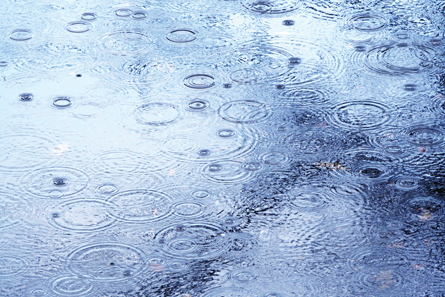Module 8—Mechanical Waves
Lesson 1—Properties of Mechanical Waves
 Get Focused
Get Focused

© Michiel de Boer/shutterstock
When two air masses with different temperature, density, and humidity meet in Earth’s atmosphere, rain is produced. In this photo, rain is falling on accumulated puddles of water, producing distinctive circular patterns. Can you tell which raindrops landed more recently than the others? If so, can you figure out exactly where they landed using the patterns observed here?
The diameter of the circular “waves” is an indication of how recently the raindrop landed on the water. The droplets that produced the larger circles shown in this photo landed before those that produced smaller circles and, if you make a couple of important assumptions, the point of impact for every droplet is at the exact centre of the circular wave. How do you know this is true? Is there a set of universal principles that govern the formation and motion of these circular waves? Do the waves all move outwards at the same speed and, if so, why?
Waves in water can be produced by sources other than rain. Consider dropping a pebble into a lake. You will see a set of ripples (waves) coming from the spot where the pebble hit the surface of the lake. Now, consider dropping a heavy boulder into the lake. In addition to the huge splash of water that would be produced, you would see a set of waves coming from the spot where the boulder was dropped. The source of waves in water is not limited to objects dropping into the water. Waves are also produced when objects come up from under the surface (such as fish) or when a disturbance occurs under the surface—such as a bomb detonating or an earthquake. Can a wave occur in water without any disturbances occurring?
As you work through this lesson, keep the following questions in mind:
- What are the properties of mechanical waves?
- What is the difference between a transverse wave and a longitudinal wave?
- How does the universal wave equation relate the frequency, speed, and length of a wave?
 Module 8: Lesson 1 Assignments
Module 8: Lesson 1 Assignments
Your teacher-marked Module 8: Lesson 1 Assignment requires you to submit a response to the following:
- Try This—TR 1, TR 2, and TR 3
- Discuss
The other questions in this lesson are not marked by the teacher; however, you should still answer these questions. The Self-Check and Try This questions are placed in this lesson to help you review important information and build key concepts that may be applied in future lessons.
After a discussion with your teacher, you must decide what to do with the questions that are not part of your assignment. For example, you may decide to submit to your teacher the responses to Try This questions that are not marked. You should record the answers to all the questions in this lesson and place those answers in your course folder.